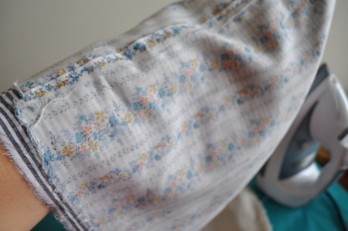posting a project I did for luv in the mommyhood:
Hello Mommyhood readers, Meg from elsiemarley here! I was absolutely thrilled when Shannon asked me to be a part of her fabulous crafty boxing match. It was a little hard to pick teams, I have to say. I learned how to crochet last year and very quickly fell in love with it. My winter was spent sitting on the couch, cranking out whatever cool crochet patterns my little fingers desired, as my poor sewing machine sat dusty and unloved in the corner. But sewing has always been my true favorite: the instant gratification of sewing wins out over the sitting on your butt part of crochet (or knitting) almost every time. And with that in mind, let’s crank out a bag that will go with everything in a few measly hours. Take that Cozy Knits! Kapow!
Every spring I get the urge to buy a completely new, bright, flirty, floral wardrobe replete with matching bags and strappy sandals, but it never happens. Even if I did have the cash for a springtime shopping spree (ha!) all those accessories wouldn’t fit in our little house. So I came up with a bag that can be many different bags all in one. It is completely reversible, so it will match all the springy outfits you already have and make them look fresh and new. It is also adjustable, so it can be a very ladylike shoulder bag or if you need to jump on your bike and go, it can become more of a messenger bag. Awesome, right? So without further ado, I give you…

materials
- 1/2 yard fabric A
- 1/2 yard fabric B
- 1/2 yard lining fabric, I prefer to use canvas or a home dec weight fabric rather than interfacing
- 20 buttons, yes 20! all the same, or 10 of one kind 10 of another, but they all should be about the same size
- sewing machine, buttonhole attachment (you can do it!)
- iron
directions

1. Out of each 1/2 yard of fabric cut two 14 inch wide by 15 inch tall pieces and one 2 inch wide by 41 inch long piece. You should have plenty of fabric to work with, but I want you to mark all the piece on your fabric first to see how it will fit. The strap will go along the top (the long side will be perpendicular to the salvage) and the two main piece of the bag should fit below it (the short side going with the salvage).

2. On the bottom of each piece cut a 1 1/4 inch square out of both corners. This is going to make a boxed bottom for the bag.

3. Now you need to sew all the pieces together.
- Start with fabric A: before you sew, mark a 4 inch wide space in the middle of the bottom edge, sew the bottom of the bag together, right sides facing, but in between the marks use a basting stitch (just a very long stitch). Take it to your ironing board and press the seam open. Then sew up both sides,right side facing. Don’t sew around the notches we cut out! the easiest way to press the side seams open is to lay your bag flat and fold down one side of the seam, iron it (see above), then flip it over and fold the other side of the seam down and iron.
- fabric B and lining: Sew the bottom seam first (no basting) right sides together and press the seam open. Sew the side seams and iron as above. Again don’t sew the notches!

4. At on of the square notches, fold the bag so that the bottom seam and the side seam line up. Iron it flat and sew closed. Do this on both notches for fabric A, fabric B, and the lining.

5. Take fabric A where we did that bit of basting and rip out all those basting stitches. This will be the hole where we turn the bag right side out, which is the next step…


6. Turn the fabric A bag right side out and put it on your hand (really!). Then take the fabric B bag, inside out, and pull it on top of fabric A. It’s important that that the right side of these two bags are facing each other. Then lastly, fit the lining (inside out or right side out, it doesn’t matter) on top. You should have a big oven mitt like thing on your hand now. Poke your fingers into the boxy corners and try to get them all to match up.
7. Line up the raw edges at the top of the bag. If all the fabrics don’t line up (mine never do) trim them so they do. Now sew all around the top of the bag.


8. Stick your hand through the hole we made in fabric A and pull out fabric B and the lining. Then stuff fabric B and the lining into fabric A. This is a little confusing to explain and weird the first time you do it, but it works I promise!

9. Iron the top edge.
10. Hand sew the hole in fabric B closed. It should be easy to make it straight and pretty much invisible because you can just follow where the basting stitches were. The best stitch to use for this is the ladder stitch.


11. Now for the strap. You should have three strap pieces–42inch by 2inches–one from each fabric. Stack them all on top on one another making sure the right sides of fabric A and fabric B are touching.
12. Lay the strap out flat. On the left side, on the bottom measure in one inch and cut from there to the end of the top edge. This just makes a pretty angled end to the strap. Do the right side, except measure in one inch from top and cut down to the end of the bottom edge.
13. Sew all around the strap, leaving about a foot wide opening in the middle of one side, so we can turn it out easily. You could also do the basting stitch trick here if you like. Turn that sucker out! You can use a chopstick, a pencil, a tweezers, whatever works, but be sure to poke the corners at the ends of the strap out. Iron it well after it’s all right side out.
14. To sew the opening closed you can topstitch all around or hand sew it–it’s up to you. If you want to topstitch it and want to match your thread to your fabrics, just put the one that matches fabric B in the bobbin and the one that matches fabric A on top. Then be sure to sew with fabric A side on top and you’re good to go.


15. Now we’re going to attach the strap to the bag! Place the strap so the pointed part is at the bottom edge and it is centered over the side seam.

16. Starting about an inch from the top of the bag lay 5 buttons along the strap all the way to the bottom (about an inch before the angled bit begins). My buttons are 1 1/2 apart, but your bag might have turned out a little bigger or smaller, so just make sure they are evenly spaced.
17. Mark where all the buttons go. Then do a test run with your buttonhole attachment on your sewing machine.

18. You can see above I have my test buttonhole next to my strap (with the mark on it), so I know about where to start the buttonhole. When you hold your awesome bag all full up with awesome stuff the button will slide down to the bottom of the buttonhole, so keep this in mind for where you place the buttonhole in relation to the button. I hope this isn’t horribly confusing–I’m trying to be extra clear so you don’t have to rip out any buttonholes, because that’s no fun.

19. Mark the buttonholes in the same way on the other side of the strap as well. Sew those buttonholes! You should have 5 on one end and 5 on the other. Carefully cut the buttonholes open. Pin the strap onto the bag and make marks through the buttonhole for where the buttons go. All the marks should all be on the side seam.


20. It’s time to sew all those buttons on. Settle in on the couch with a needle and thread (and a podcast or two). You are going to sew two buttons at a time: they will be in the same place, but one will be on one side and one on the other. The awesome bag is reversible, remember? Start at the top and attach the first button with one stitch, then when you go through the fabric attach the button on the other side. This is a little fiddly, but it will cut your sewing time in half. When you are finished you should have 20 buttons sewn on!
21. Button your strap up however you like, on whichever side goes with the very cute outfit you have on today. Ta Da! you made The Awesome Bag. You are awesome!





















































